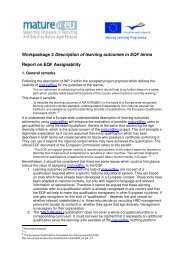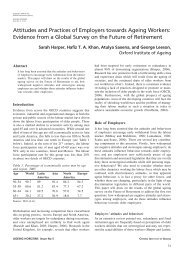Age profiling - Mature @ EU
Age profiling - Mature @ EU
Age profiling - Mature @ EU
- No tags were found...
Create successful ePaper yourself
Turn your PDF publications into a flip-book with our unique Google optimized e-Paper software.
Spring 2002<br />
THE ESSENTIAL GUIDE TO<br />
AGE PROFILING<br />
1<br />
2<br />
3<br />
4<br />
What shape success<br />
Can you spot the possible implications if your<br />
business has one or more of these age profiles<br />
See the back page for the answers!
<strong>Age</strong> <strong>profiling</strong><br />
The essential tool for HR professionals<br />
The HR world is renowned for its use of jargon. One of the<br />
latest buzzwords is ‘age <strong>profiling</strong>’. But what does it mean and<br />
can it actually help steer your business<br />
<strong>Age</strong> <strong>profiling</strong> is an efficient technique to map the<br />
age of a group of people, typically a workforce or<br />
customer base. And whilst a blanket profile of your<br />
business will tell you little except that you employ<br />
people of different ages, targeted age <strong>profiling</strong> can<br />
be a very useful tool.<br />
Used effectively, age <strong>profiling</strong> can help you evaluate<br />
arange of personnel issues including performance,<br />
employee satisfaction, recruitment and retention<br />
levels. It can help identify risks and opportunities<br />
amongst key groups or business functions and most<br />
importantly allow you to plan for future needs.<br />
It is an technique that is increasingly being used by<br />
smart employers to measure business performance.<br />
GSK<br />
“A simple statistical analysis of some raw<br />
HR data underlined how frequently even<br />
HR teams, tend to make assumptions about<br />
employees. In one part of the company,<br />
there seemed to be a dip post 39.We<br />
thought we knew why. However, further<br />
analysis – cross-referring age to other<br />
factors – quickly showed those assumptions<br />
to be wrong.This small piece of work has<br />
resulted in GSK reviewing (and in some<br />
instances revising) HR systems and policy.<br />
We have already scheduled further discrete<br />
projects in key business areas, where we<br />
anticipate age <strong>profiling</strong> will provide very<br />
useful current and projected trend data.”<br />
Ian Brown<br />
UK Diversity Director, GSK<br />
<strong>Age</strong> <strong>profiling</strong> categories<br />
EFA recommends the following categories may<br />
be helpful for age <strong>profiling</strong> as they marry with<br />
Government statistics and with bands that are<br />
used by many UK employers.<br />
16-24; 25-34; 35-44; 45-54; 55-64 etc<br />
This latest version of the famous EFA ‘wave chart’<br />
illustrates the enormous changes that are taking<br />
place in the shape and balance of UK demographics.<br />
It is these dramatic changes – mirrored across the<br />
whole of Europe – that are now driving national<br />
and employment policy review.<br />
UK Population Projections<br />
Thousands<br />
5000<br />
4500<br />
4000<br />
3500<br />
3000<br />
2500<br />
2002<br />
15-24 25-34 35-44 45-54 55-64<br />
Source: ONS 2002<br />
2006<br />
2015<br />
<strong>Age</strong><br />
2020<br />
2025
Co-operative Bank<br />
A robust system was developed to produce accurate statistical data which is shared<br />
bankwide on a six monthly basis with all Executive and Senior Managers.The Co-op Bank’s<br />
profile is regularly measured against national and regional trends and results published<br />
annually. In 2001 data on age was included for the first time in the bank’s annual report and<br />
showed that the bank was reflecting demographic trends with 32% of the workforce being<br />
aged over 40. However, further analysis did identify considerable differences in the age profile<br />
from one business unit to another. For instance the age profile in smile, (the Bank’s internet<br />
banking service) was much younger with over 85% of it’s staff under the age of 35 compared<br />
to the Bank average of 49% Smile were concerned that candidates were de-selecting<br />
themselves believing “Internet Banking” was for the younger person.They therefore included<br />
the statement “We welcome applications from all ages” to change this belief.This has now<br />
had the positive result of a 5% improvement.<br />
Viv O’Connell, Human Resources Relationship Manager, Co-operative Bank<br />
Risk analysis<br />
The age <strong>profiling</strong> of particular teams will quickly<br />
identify potential risks, either current gaps or future<br />
loss of personnel, and knowledge. <strong>Age</strong> <strong>profiling</strong> will<br />
help you to look ahead and to effectively anticipate<br />
skill needs and demand, as well as supporting<br />
succession planning. It will also help you predict<br />
future costs – e.g. pensions.<br />
A comparison of the current working age<br />
population with the projected population in 2020<br />
clearly highlights the age cohorts that will either<br />
shrink or grow in 20 years.<br />
UK Working <strong>Age</strong> Population 2002<br />
compared to 2020<br />
Thousands<br />
5000<br />
4500<br />
4000<br />
3500<br />
3000<br />
2500<br />
15-19<br />
20-24<br />
Source: ONS 2002<br />
25-29<br />
30-34<br />
35-39<br />
2002 2020<br />
<strong>Age</strong><br />
40-44<br />
45-49<br />
50-54<br />
55-59<br />
60-65<br />
An age profile can help explain a department or<br />
team’s turnover (in general an older profile will be<br />
more static than a younger). It may also account<br />
for differences in performance – there can be a<br />
correlation between the age-mix and productivity<br />
or outcomes such as sales. By looking at selected<br />
age profiles you can easily spot any problems that<br />
might lie ahead.<br />
Avoiding unnecessary skills loss<br />
Many organisations still put themselves at risk<br />
by not age <strong>profiling</strong> prior to a redundancy or<br />
voluntary severance programme. <strong>Age</strong> <strong>profiling</strong><br />
combined with a skills gap analysis can help you<br />
avoid the unnecessary loss of experience and<br />
knowledge that can sometimes leave an<br />
organisation operationally challenged.<br />
John Menzies<br />
We were conscious that a number of key<br />
executives were nearing retirement age,<br />
and an age <strong>profiling</strong> exercise confirmed<br />
that 25% of our most senior executives<br />
are due to retire within the next five<br />
years.The age <strong>profiling</strong> exercise has<br />
therefore been helpful in terms of<br />
reviewing our succession planning and<br />
retention practices.<br />
We now want to age profile the entire<br />
workforce as we feel that this will have<br />
wider links with other diversity and HR<br />
issues. Equity has to be the watchword.<br />
Jim Warnock, Director of Group<br />
Personnel, John Menzies plc
HM Land Registry<br />
“<strong>Age</strong> seemed to be the one diversity issue that all managers could relate to”, said, John<br />
Nicholson when he joined HMLR in 2000. “We decided to age profile across the whole<br />
business and then carry out a further analysis by job band. <strong>Age</strong> <strong>profiling</strong> was unexpectedly<br />
useful in that it has helped forge the link in with other issues, and support the holistic<br />
approach to diversity we are striving to achieve. For instance, we felt we should try and<br />
attract more younger workers and women returners and age <strong>profiling</strong> suggested we<br />
should not only review our ethnic minority policies but also revisit how we promoted<br />
flexible working and child care provision.”<br />
John Nicholson, Head of Diversity HMLR<br />
“<strong>Age</strong> <strong>profiling</strong> can provide a focussed snapshot<br />
of your workforce and is a useful additional<br />
method of measuring business performance.”<br />
Recruitment and retention<br />
<strong>Age</strong> <strong>profiling</strong> is one of the most powerful tools<br />
you can use to measure the effectiveness of<br />
recruitment policies and to establish whether<br />
you are an employer of choice.<br />
By <strong>profiling</strong> the applicant pool, interview pool, and<br />
successfully appointed personnel you can learn much<br />
about your recruitment process. By then measuring<br />
the age profile of those exiting the business, say at<br />
3 months, 6 months and a year, further evidence<br />
can be gathered about the effectiveness of your<br />
recruitment and induction system.<br />
But different businesses have – and are happy with<br />
– different rates of turnover. For you it may not be<br />
a question of recruitment, but of retention. Once<br />
again age <strong>profiling</strong> will help you better understand<br />
the current picture and provide useful indictors on<br />
how best to retain, rather than recruit staff.<br />
In fact, the age <strong>profiling</strong> of personnel exiting the<br />
organisation correlated against their reasons for<br />
leaving may well provide clear indications of<br />
frustrations within certain age categories.Your<br />
business may be losing high fliers, managers of the<br />
future, or key personnel.<br />
Employee satisfaction<br />
A number of organisations now include age as<br />
a factor in employee surveys. Analysing the results<br />
by age may provide you with evidence of varying<br />
satisfaction levels within different age groups of<br />
staff. Added to analysis of exit information, this<br />
data could also provide evidence of how well<br />
you are meeting your employees’ expectations.<br />
EFA consider it essential to cross refer age statistics<br />
with other diversity statistics, such as gender, race,<br />
disability, etc.<br />
Work-life balance and family<br />
friendly policies<br />
Many organisations have initiated policies that<br />
address work-life balance issues. Often these are<br />
focussed around the needs of a particular group<br />
of workers – such as women with young children.<br />
However, analysis of your employees by age, may<br />
well highlight that growing numbers may have<br />
elder-care, rather than child-care needs.<br />
<strong>Age</strong> <strong>profiling</strong> – a lever for change<br />
<strong>Age</strong> <strong>profiling</strong> provides you with a sophisticated<br />
technique that will deliver internal evidence to<br />
support a change of policy or to encourage<br />
better practice.
Cross referencing<br />
EFA encourages employers to cross refer age<br />
profiles with other diversity statistics such as<br />
gender, race, disability etc.<br />
Regional demographics show considerable<br />
variation, so it is always worthwhile crosschecking<br />
your local business profile with<br />
regional or local statistics.<br />
The chart below compares Greater London<br />
with the South West.The differing profiles<br />
are immediately apparent.<br />
Projected female labour force 2006<br />
Thousands<br />
500<br />
400<br />
300<br />
200<br />
260<br />
195<br />
400<br />
210<br />
495<br />
310<br />
16-24 25-34 35-44 45-59<br />
<strong>Age</strong><br />
Greater London South West<br />
480<br />
395<br />
<strong>Age</strong> <strong>profiling</strong> and the law<br />
It is uncertain whether the future age<br />
discrimination legislation, due to be enacted by<br />
2006, will force employers to age profile. Many<br />
commentators predict that the legislation may<br />
require statistical monitoring of staff by age.<br />
Employers who regularly age profile their staff as<br />
part of their HR and diversity monitoring systems,<br />
will certainly be better placed, should they have to<br />
‘justify’ any action in a tribunal.<br />
The FIVE ‘E’s of age <strong>profiling</strong>:<br />
Efficient<br />
helps Evaluate<br />
is Effective and<br />
provides Evidence<br />
In fact it is Essential<br />
New Bullet tbc<br />
Source: ONS 2002<br />
“<strong>Age</strong> <strong>profiling</strong> provides alternative ways of<br />
looking at your people – while it can’t provide<br />
a cure, it can confirm a diagnosis!”<br />
<strong>Age</strong> <strong>profiling</strong> – a practical guide<br />
DO’S<br />
Do focus in on key teams, departments<br />
or business units<br />
Do cross refer age to other diversity/HR issues<br />
Do measure your profile against that of your<br />
customers to identify opportunities<br />
Do check your profile against that of your region<br />
or locality<br />
Do look at applicants or those leaving<br />
the business<br />
Do compare your profile against future needs<br />
Do remember when making comparisons that<br />
demographics vary significantly across the UK<br />
DON’TS<br />
Don’t just look at the whole business<br />
Don’t just measure by age<br />
Don’t just monitor employees<br />
Don’t forget to keep records, you may need<br />
evidence in the future<br />
Don’t just monitor existing staff<br />
Don’t just look at the picture now<br />
Don’t underestimate the projected shift in the<br />
UK population over the next 20 years
Answers to our age <strong>profiling</strong> quiz<br />
1 Beware – an age profile like this might have serious implications for internal communication<br />
and intergenerational understanding. Why doesn’t anyone in their 30’s want to work for you<br />
2 How will your business cope in the future You are losing too many people,<br />
you won’t be able to replace them – look at the changing UK demographics.<br />
3 Watch out most of your workforce is concentrated between the ages of 29 and 45.<br />
How wide a range of experience, lifestyles and ideas are you getting<br />
4 Can you really afford such a large loss of talent in such a short period<br />
You might need to rethink your retirement policies.<br />
Astral House<br />
1268 London Road<br />
London<br />
SW16 4ER<br />
Tel: 020 8765 7597<br />
Fax: 020 8765 7374<br />
efa@ace.org.uk<br />
www.efa.org.uk<br />
‘The Employers Forum on <strong>Age</strong> (EFA) is the first ever employer-led initiative to promote the business<br />
benefits on an age diverse workforce.The EFA is the leading authority on age issues in the workplace and<br />
offers expert advice and support to employers on managing the skills and age-mix of their organisations.’<br />
<strong>Age</strong> diverse employers are smart employers who have nothing to fear from legislation
Job<br />
Track<br />
Date 16.04.02<br />
3<br />
Job No 529<br />
Job title<br />
EFA <strong>Age</strong> Profiling Factsheet<br />
File title<br />
529v04_EFA_<strong>Age</strong>Pro.Factsheet.qxd<br />
Product code XX<br />
Account Manager Matt Eley<br />
Designer Neil<br />
Artworker Tim Eng<br />
Proof size 100%<br />
Account Manager<br />
Designer<br />
Artworker<br />
Print details<br />
Number of colours<br />
Number of pages 6<br />
Special finishings X
















